Download PDF
Download page Reach Sediment.
Reach Sediment
Sediment processes within a reach are directly linked to the stream flow and its capacity to carry eroded soil. The transport capacity of the stream can be calculated from flow and sediment properties. If the stream can transport more sediment than is contained in the inflow, additional sediment will be eroded from the stream bed and entrained in the flow. However, if the flow in the reach cannot transport the sediment, entrained sediment will settle and deposit in the reach bed.
The sediment transport capacity is calculated based off a transport potential method. Any Basin Model that uses Muskingum-Cunge or Kinematic Wave routing methods will need to carefully choose an index flow or an index celerity for each reach element. The index flow and celerity is used to subdivide the reach into an equal number of length segments (dx) as expressed in the courant condition. The Volume Ratio and Linear Reservoir sediment routing methods are very sensitive with “dx” and may drastically change computed sediment results.
Deposition of sediment from the water column to the stream bed requires time. The Fall Velocity for a grain size class describes how much time is expected for sediment to settle from the water column to the stream bed. The settling velocity is calculated and multiplied by the time interval to determine the settling distance in one time interval. This settling distance is then compared to the flow depth calculated during flow routing in order to determine the fraction of calculated deposition which is actually permitted during a time interval. The approach here is similar to the one used in HEC-RAS.
The erosion of sediment from the stream bed and entraining into the stream flow requires time. Limits to erosion have been observed. An empirical rule is used by selecting a characteristic flow length necessary for erosion. Erosion is limited when the length of the reach divided by the flow depth is less than 30. This empirical rule is similar to one used in HEC-RAS.
The reach bed is represented by a two-layer model. The upper layer represents the top of the stream bed which actively interacts with the flow field. This layer responds relatively quickly to changes to the flow rate. The lower layer is linked to the upper layer with a simple bed mixing algorithm. The lower layer represents the underlying substrate of the reach. Long-term processes that lead to a reach being either a sediment sink or sediment source within the watershed are represented through the lower layer. The two-layer model is also capable of representing an "armoring" condition, which reduces the rate of erosion as the upper layer coarsens.
The cross section shape of the channel is assumed fixed. Changes to the reach from sediment and flow dynamics are not represented during the simulation. A characteristic width and depth of the sediment bed is used to represent the two-layer model.
Selecting a Sediment Method
The Sediment Method for a reach is selected on the Component Editor for the Reach Element (shown in the following figure). Access the Component Editor by clicking the Reach Element icon on the Components tab of the Watershed Explorer. You can also access the Component Editor by clicking on the element icon in the Basin Map. You can select a Sediment Method from the list of five available choices. If you choose None, the reach will not compute any sediment and all sediment discharges from the element will be zero. Use the selection list to choose the method you wish to use. Each reach may use a different method or several reaches may use the same method.
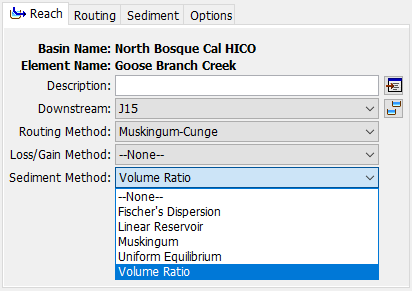
The parameters for each Sediment Method are shown on the Sediment tab of the Component Editor. The Sediment editor is always shown next to the Routing editor. The information shown on the Sediment editor will depend on which method is currently selected.
Fisher's Dispersion
The Fisher's Dispersion Method is based on an analysis of advection and diffusion of sediment within a reach (Fisher et al., 1979). This is the most detailed of the sediment routing methods and requires more data than the other available methods. Advection and diffusion, represented as Travel and Dispersion parameters, need to be specified for each grain size class. This permits large-grained sediments to move slower than fine-grained sediments. For each time interval, sediment from the upstream elements are added to the sediment already in the reach. After erosion or deposition is calculated, the remaining available sediment is translated in the reach by a Travel Time and attenuated through a diffusion process. The advection and diffusion of sediment are linked to the velocity of water in the reach which is calculated during the flow routing. The Component Editor is shown in the following figure.
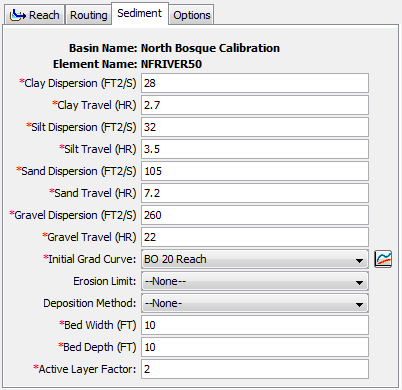
Dispersion Coefficient must be specified for each grain class (clay, silt, sand, gravel). The Dispersion coefficient indicates the diffusion of the particles during transit through the reach and is dependent on the channel geometry. The dispersion coefficient can vary over several orders of magnitude and often must be adjusted during calibration. Some guidance is available for estimating the dispersion coefficient from Kashefipour and Falconer (2002). The Travel Time must also be specified for each grain class and is often close to the travel time for water in the reach. When the AGU 20 grain size classification is used, the same dispersion and retention values are used for all subclasses of grain classes.
The Initial Gradation Curve defines the distribution of the bed sediment by grain size at the beginning of the simulation. The same curve is used in both the upper and lower layers of the two-layer bed model. The gradation curve is defined as a Diameter-Percentage function in the Paired Data Manager.
The Erosion Limit is optional. If the erosion limit is selected as None, erosion is limited only by the transport capacity of the flow. When the Erosion Limit is selected as Yes, erosion is reduced when the ratio of the reach length to flow depth is less than 30. Erosion limits are usually encountered in very short reaches.
The Deposition Limit is optional. When the deposition limit is deactivated, sediment in excess of the transport capacity is deposited completely. When the Deposition Limit is selected to Yes, sediment is limited by the flow depth calculated during flow routing and the fall velocity of each grain size. The fall velocity is computed using the method selected within the Basin Model properties. Selecting a Deposition Limit requires users to select a Temperature Method. Users may specify a fixed water temperature (Average) or select a temperature time-series gage (Time Series). Temperature gages must be created in the Time-Series Data Manager before they can be used.
The Bed Width must be specified. The width should be representative of the entire reach. The width is used to compute the volume of the upper and lower layers of the bed model. The Bed Depth must also be specified. The depth should be representative of the reach depth for both the upper and lower layers, representing the maximum depth of mixing over very long time periods.
The Active Layer Factor is used to calculate the depth of the upper layer of the bed model. At each time interval, the upper layer depth is computed as the d90 of the sediment in the upper layer, multiplied by the active layer factor.
Linear Reservoir
The Linear Reservoir Method uses a simple linear reservoir to route each grain size through the reach. For each time interval, sediment is calculated from the upstream sediment and local erosion or deposition. The available sediment in each grain size class is routed through a linear reservoir independently of the hydrologic routing of the flow. This allows sediment of different grain sizes to move at different speeds through the reach. Calibration with observed data is recommended to assign parameter values. The Component Editor is shown in the following figure.
The Retention parameter is equivalent to the storage coefficient and is used to route the sediment through the reach. The routing is performed separately for clay, silt, sand, and gravel. When the AGU 20 grain size classification is used, the same retention is used for all subclasses of each class. The value of the retention parameter is analogous to the median length of time for each sediment class to move through the reach. The Retention value may change for each sediment size class but is often close to the travel time for water in the reach.
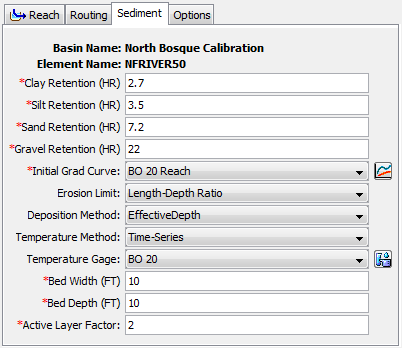
The Initial Gradation Curve defines the distribution of the bed sediment by grain size at the beginning of the simulation. The same curve is used in both the upper and lower layers of the two-layer bed model. The gradation curve is defined as a Diameter-Percentage function in the Paired Data Manager.
The Erosion Limit is optional. If the erosion limit is selected as None, erosion is limited only by the transport capacity of the flow. When the Erosion Limit is selected as Yes, erosion is reduced when the ratio of the reach length to flow depth is less than 30. Erosion limits are usually encountered in very short reaches.
The Deposition Limit is optional. When the deposition limit is deactivated, sediment in excess of the transport capacity is deposited completely. When the Deposition Limit is selected to Yes, sediment is limited by the flow depth calculated during flow routing and the fall velocity of each grain size. The fall velocity is computed using the method selected within the Basin Model properties. Selecting a Deposition Limit requires users to select a Temperature Method. Users may specify a fixed water temperature (Average) or select a temperature time-series gage (Time Series). Temperature gages must be created in the Time-Series Data Manager before they can be used.
The Bed Width must be specified. The width should be representative of the entire reach. The width is used to compute the volume of the upper and lower layers of the bed model. The Bed Depth must also be specified. The depth should be representative of the reach depth for both the upper and lower layers, representing the maximum depth of mixing over very long time periods.
The Active Layer Factor is used to calculate the depth of the upper layer of the bed model. At each time interval, the upper layer depth is computed as the d90 of the sediment in the upper layer, multiplied by the active layer factor.
Muskingum
The Muskingum Method uses a simple conservation of mass approach to route sediment/debris through the stream reach. For each time interval, available sediment is calculated from the upstream sediment and local erosion or deposition. The available sediment in each grain size class is routed using the Muskingum routing parameters, Attenuation Coefficient and Travel Time. This allows sediment of different grain sizes to move at different speeds and as well as approximate attenuation through the reach. Calibration with observed data is recommended to assign parameter values. The Component Editor is shown in the following figure.
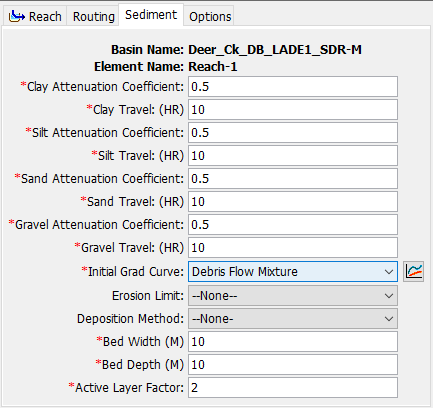
The Attenuation Coefficient of each grain class is the weighting between inflow and outflow influence; it ranges from 0.0 up to 0.5. In practical application, a value of 0.0 results in maximum attenuation and 0.5 results in no attenuation. Most stream reaches require an intermediate value found through calibration.
The Travel: (HR) of each grain class is essentially the travel time through the reach. It can be estimated from knowledge of the cross section properties and flow properties. It may be a calibration parameter in some cases.
The Initial Gradation Curve defines the distribution of the bed sediment by grain size at the beginning of the simulation. The same curve is used in both the upper and lower layers of the two-layer bed model. The gradation curve is defined as a Diameter-Percentage function in the Paired Data Manager.
The Erosion Limit is optional. If the erosion limit is selected as None, erosion is limited only by the transport capacity of the flow. When the Erosion Limit is selected as Yes, erosion is reduced when the ratio of the reach length to flow depth is less than 30. Erosion limits are usually encountered in very short reaches.
The Deposition Limit is optional. When the deposition limit is deactivated, sediment in excess of the transport capacity is deposited completely. When the Deposition Limit is selected to Yes, sediment is limited by the flow depth calculated during flow routing and the fall velocity of each grain size. The fall velocity is computed using the method selected within the Basin Model properties. Selecting a Deposition Limit requires users to select a Temperature Method. Users may specify a fixed water temperature (Average) or select a temperature time-series gage (Time Series). Temperature gages must be created in the Time-Series Data Manager before they can be used.
The Bed Width must be specified. The width should be representative of the entire reach. The width is used to compute the volume of the upper and lower layers of the bed model. The Bed Depth must also be specified. The depth should be representative of the reach depth for both the upper and lower layers, representing the maximum depth of mixing over very long time periods.
The Active Layer Factor is used to calculate the depth of the upper layer of the bed model. At each time interval, the upper layer depth is computed as the d90 of the sediment in the upper layer, multiplied by the active layer factor.
Uniform Equilibrium
The Uniform Equilibrium Method assumes the sediment is translated instantaneously through the reach. It is the simplest method because it does not compute any temporal lag for the sediment passing through the reach. Sediment enters the reach from upstream elements. The transport capacity for each grain size is calculated to determine whether the stream is depositing or eroding. The available sediment is computed subject to the limitations on deposition and erosion. The remaining sediment is then routed regardless of the velocity. The Component Editor for the Uniform Equilibrium method is shown in the following figure.
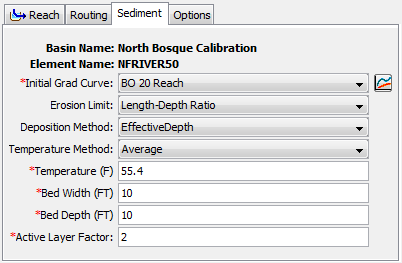
The Initial Gradation Curve defines the distribution of the bed sediment by grain size at the beginning of the simulation. The same curve is used in both the upper and lower layers of the two-layer bed model. The gradation curve is defined as a Diameter-Percentage function in the Paired Data Manager.
The Erosion Limit is optional. If the erosion limit is selected as None, erosion is limited only by the transport capacity of the flow. When the Erosion Limit is selected as Yes, erosion is reduced when the ratio of the reach length to flow depth is less than 30. Erosion limits are usually encountered in very short reaches.
The Deposition Limit is optional. When the deposition limit is deactivated, sediment in excess of the transport capacity is deposited completely. When the Deposition Limit is selected to Yes, sediment is limited by the flow depth calculated during flow routing and the fall velocity of each grain size. The fall velocity is computed using the method selected within the Basin Model properties. Selecting a Deposition Limit requires users to select a Temperature Method. Users may specify a fixed water temperature (Average) or select a temperature time-series gage (Time Series). Temperature gages must be created in the Time-Series Data Manager before they can be used.
The Bed Width must be specified. The width should be representative of the entire reach. The width is used to compute the volume of the upper and lower layers of the bed model. The Bed Depth must also be specified. The depth should be representative of the reach depth for both the upper and lower layers, representing the maximum depth of mixing over very long time periods.
The Active Layer Factor is used to calculate the depth of the upper layer of the bed model. At each time interval, the upper layer depth is computed as the d90 of the sediment in the upper layer, multiplied by the active layer factor.
Volume Ratio
The Volume Ratio Method directly pairs the sediment transport to the streamflow. For each time interval, sediment from the upstream elements is added to the sediment already in the reach. Deposition or erosion is calculated for each grain size to determine the available sediment for routing. The proportion of available sediment that leaves the reach in each time interval is assumed equal to the proportion of stream flow that leaves the reach during that same interval. This means that the all grain sizes are transported through the reach at the same rate, even though erosion and deposition are determined separately for each grain size. This assumption essentially limits the advection velocity of the sediment to the bulk water velocity. Therefore, this method is a higher fidelity option than the Uniform Equilibrium Method (without requiring much more data) but less precise than the other available methods which require substantially more data. This method is similar to the approach used in the Soil and Water Assessment Tool Model (Gassman, 2007). The Component Editor is shown in the following figure.
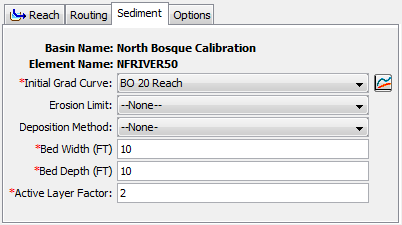
The Initial Gradation Curve defines the distribution of the bed sediment by grain size at the beginning of the simulation. The same curve is used in both the upper and lower layers of the two-layer bed model. The gradation curve is defined as a Diameter-Percentage function in the Paired Data Manager.
The Erosion Limit is optional. If the erosion limit is selected as None, erosion is limited only by the transport capacity of the flow. When the Erosion Limit is selected as Yes, erosion is reduced when the ratio of the reach length to flow depth is less than 30. Erosion limits are usually encountered in very short reaches.
The Deposition Limit is optional. When the deposition limit is deactivated, sediment in excess of the transport capacity is deposited completely. When the Deposition Limit is selected to Yes, sediment is limited by the flow depth calculated during flow routing and the fall velocity of each grain size. The fall velocity is computed using the method selected within the Basin Model properties. Selecting a Deposition Limit requires users to select a Temperature Method. Users may specify a fixed water temperature (Average) or select a temperature time-series gage (Time Series). Temperature gages must be created in the Time-Series Data Manager before they can be used.
The Bed Width must be specified. The width should be representative of the entire reach. The width is used to compute the volume of the upper and lower layers of the bed model. The Bed Depth must also be specified. The depth should be representative of the reach depth for both the upper and lower layers, representing the maximum depth of mixing over very long time periods.
The Active Layer Factor is used to calculate the depth of the upper layer of the bed model. At each time interval, the upper layer depth is computed as the d90 of the sediment in the upper layer, multiplied by the active layer factor.